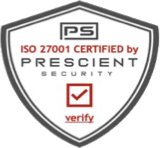Enterprise risk management (ERM) is an organizational strategy to identify and mitigate risks to a corporation’s legal, financial, and operational objectives. An ERM strategy allows key stakeholders to assess risks to the corporate entity. Using the results of these assessments, department heads determine the best course of action to mitigate risks.
Creating a diligent ERM framework creates awareness throughout the business about risks posed to corporate governance, legal compliance, and business profitability. Utilizing technology, such as entity management software, creates a centralized source of truth for all aspects of the risk management strategy. Stakeholders inquiring about the plan can refer to the platform for answers.
What is the purpose of an enterprise risk management plan?
An effective ERM strategy takes a holistic approach to managing risks throughout the corporate enterprise. Risk managers use an ERM plan to minimize risks while also identifying opportunities to improve operations.
Innovative or efficient workflows can improve, for example, how legal or financial data is reported to corporate executives and directors. When analyzed using the corporation’s ERM strategy, these new efficiencies can streamline business costs while preserving effective risk management.
What risks does an ERM framework address?
Anything that threatens the legal or financial integrity of a business is classified as a risk. However, most corporate risks can be classified into one of the following categories.
Corporate compliance
Corporate compliance risks are any actions taken by a company that violate jurisdictional laws or regulations. As an example, failing to produce annual financial statements to authorities within established timeframes risks violating compliance.
Take note that there are differences between compliance and ethical risks. Violations of compliance policies could subject the corporate entity to serious financial and, in some cases, criminal penalties. Ethical violations may be classified as legal, though they reflect poorly on responsible governance and the brand reputation.
Legal matters
Similar to corporate compliance, general legal risks threaten a corporate entity with substantial financial repercussions. A prime example of a legal risk is a contractual dispute with a vendor or third-party affiliate that results in a lawsuit brought against the corporation.
Business strategy
Changes in global economic conditions threaten the overarching corporate strategy of the business. These risks are largely beyond the control of the corporation, so having a thought-out ERM strategy enables your business to change course against troubling economic headwinds.
Business operations
Similar to economic instability, some unexpected risks affect global operations. For example, disruptions to the global supply chain, fueled by events like the ongoing war in Ukraine, have hindered business activity throughout the world.
Data security
Data security has always been an important part of any ERM framework. In recent years, the rise of invasive and disruptive cybersecurity data breaches has only accelerated the global need for robust data security measures. Ensure your ERM framework directly addresses cybersecurity and balances this matter with the cost of not improving data security protocols.
Financial performance
Of course, no risk management plan is complete without considering risks to financial performance. Anything that increases corporate debt or reduces profits is a risk to business growth and must be appropriately considered within your ERM framework.
5 components of an effective ERM framework
Now that we’ve identified areas in which an ERM strategy best serves your corporate entity, what are the key components of an effective ERM framework? Generally speaking, there are five important ways to build and maintain an ERM plan.
Risk identification
The first step is to identify the risks to your business. Assess the costs to your corporation from each identified risk so that you can evaluate proper solutions to mitigate those risks. Then, determine the cost to implement those solutions so that you can develop enterprise risk management in a structured manner.
Risk ownership and response
The second component of your ERM framework is to determine which stakeholder is responsible for mitigating risks in a particular aspect of the business. Assigning risk ownership to the appropriate leader ensures matters are not overlooked and solutions are implemented.
Risk control policies
Next, determine how you will solve matters of risk to the business structure. A great example of how to do so lies within compliance risks. By using entity management software, you have access to built-in compliance frameworks that use modules, wizards, and prompt notifications to enforce strict compliance throughout the organization. If there are any gaps in reported compliance data, the platform alerts users of these gaps so that corrective action can be taken.
Risk monitoring and reporting
Upon selecting viable solutions to manage corporate risks, set in place a process to monitor and report any subsequent risks. Start by creating ERM objectives and the list of stakeholders who are assigned responsibility for certain aspects of risk. Then, create a risk registration workflow that allows risk managers to monitor any deviations from the established framework.
Risk assurance
Finally, as proper monitoring and reporting structures are implemented, establish a process that allows business leaders to evaluate all reporting data. Use the takeaways from those reports to assess and continuously improve the ERM framework so that you’re constantly controlling risks to the corporation.
Use entity management software to help minimize risk
Solutions like entity management software are a boon to organizations that desire a structured approach to risk management. All reporting entity data is stored within cloud-based servers that are backed by biometric and hardware key authentication solutions. Join the MinuteBox revolution today and take your corporation one step closer to effective risk management.


